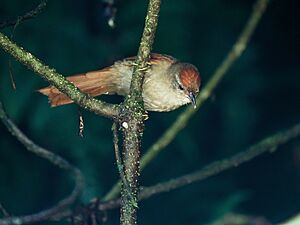Ash-browed spinetail facts for kids
Quick facts for kids Ash-browed spinetail |
|
|---|---|
 |
|
| Conservation status | |
| Scientific classification | |
| Genus: |
Cranioleuca
|
| Species: |
curtata
|
 |
|
The ash-browed spinetail (Cranioleuca curtata) is a small bird that belongs to the ovenbird family called Furnariidae. You can find this bird in several South American countries, including Bolivia, Colombia, Ecuador, and Peru.
Contents
About the Ash-browed Spinetail
The ash-browed spinetail has three different types, or subspecies. These are C. c. curtata, C. c. cisandina, and C. c. debilis. Each subspecies has slight differences, often in their colors or where they live.
What Does the Ash-browed Spinetail Look Like?
This bird is about 14 to 15 centimeters (5.5 to 5.9 inches) long. It weighs between 14 and 21 grams (0.5 to 0.7 ounces), which is about as much as a few quarters. Both male and female ash-browed spinetails look very similar.
They have a stripe above their eye, like an eyebrow, which can be whitish or grayish. The rest of their face is brownish. Their head is a reddish-chestnut color, and their back is a rich brown. Their wings and tail are also reddish-chestnut.
The tail is tapered, and sometimes the very ends of the feathers are bare. Their chin is a very light gray, and their throat is a bit browner. The underside of their body is dull brownish. Their eyes are chestnut or brown. Their upper beak is dark brown, and their lower beak is usually pinkish with a dark tip. Their legs and feet are olive-greenish or yellowish.
Young ash-browed spinetails have a stronger eyebrow stripe. Their head is mostly brown, and their undersides are yellowish-brown or reddish-brown.
Where the Ash-browed Spinetail Lives
The different subspecies of the ash-browed spinetail live in different areas.
- The C. c. curtata subspecies lives in the northern part of its range, on the western slopes of Colombia's Eastern Andes mountains.
- The C. c. cisandina subspecies lives on the eastern slopes of the Andes, from Colombia south through Ecuador and into Peru.
- The C. c. debilis subspecies is found further south, from Peru into Bolivia.
These birds like to live in damp forests on hillsides and in mountains. They are usually found at elevations between 800 and 2300 meters (2,600 to 7,500 feet) above sea level.
How the Ash-browed Spinetail Behaves
Movement
The ash-browed spinetail stays in the same area all year round. It does not migrate.
Feeding
This bird mainly eats arthropods, which are small creatures like insects and spiders. It usually looks for food alone or in pairs. Sometimes, it joins a mixed-species feeding flock, which is a group of different bird species feeding together.
The spinetail often searches for food in the middle and lower parts of the trees. It is very agile, poking around in bark, moss, and dead leaves. It can even hang upside down to find its prey!
Breeding
Scientists don't know much about how the ash-browed spinetail raises its young. Only one young bird has ever been seen in northern Ecuador in March.
Vocalization
The ash-browed spinetail has a unique song. It's often described as a high-pitched, fast series of shrill notes. The song gets faster and then fades away, sometimes ending in a trill.
Conservation Status
The IUCN (International Union for Conservation of Nature) has changed its assessment of the ash-browed spinetail's status a few times. Currently, it is listed as "Least Concern." This means it is not in immediate danger of extinction.
However, the bird's population is believed to be decreasing. The biggest threat to this species is deforestation. Forests where these birds live are being cut down for ranching and farming. Even though it lives in a very large area, and can be found in some protected places, losing its forest home is a big problem for the ash-browed spinetail.


